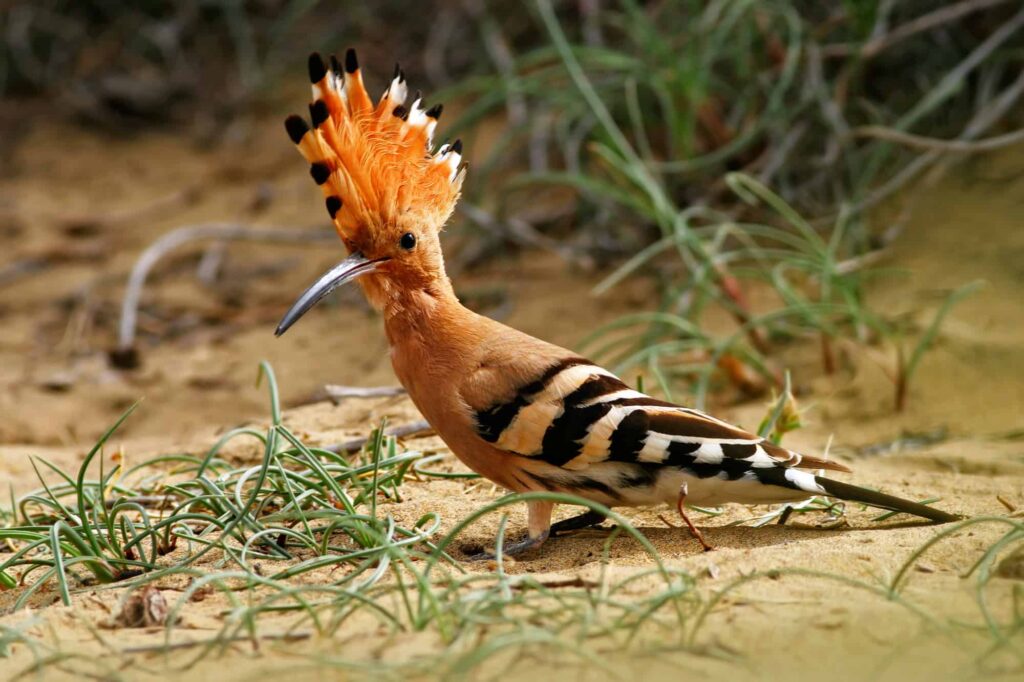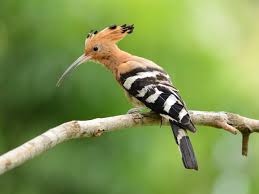A Unique Appearance and Set of Behaviours
The Eurasian Hoopoe is a frequent visitor to Cyprus, with its unmistakable appearance and unique calls making it a favourite among bird enthusiasts. The bird is found in a variety of habitats across the island, from forests and gardens to urban areas. Its striking appearance, with a distinctive crown of feathers and a long, curved bill, makes it easy to spot. The hoopoe is also known for its distinctive “hoop-hoop” call, which can be heard from a distance. Despite being a common sight in Cyprus, the hoopoe is still a protected species and is one of the many natural wonders that make the island such a special place.
Appearance
The Eurasian Hoopoe is a uniquely distinctive bird, with a striking appearance that makes it easily recognizable. The bird’s most notable feature is its long, thin, and curved bill, which is perfectly adapted for probing the ground and probing for insects. The hoopoe’s head is adorned with a crown of striking feathers, with a

mix of black, white, and cinnamon colours. The bird’s back and wings are covered in brown and black feathers, while the underparts are white. The hoopoe also has a distinctive crest of feathers on its head, which it can raise or lower depending on its mood. Overall, the Eurasian Hoopoe is a beautiful and fascinating bird that is sure to captivate anyone who sees it.
Habitat
The Eurasian Hoopoe can be found in a wide variety of habitats across Europe, Asia, and Africa. In Cyprus, the bird is most commonly found in open woodlands, parks, gardens, and even urban areas. The hoopoe prefers areas with open ground where it can forage for insects, such as grasslands, fields, and pastures. It also requires trees or bushes for nesting and roosting. The hoopoe is a migratory bird, spending the winter months in Africa and returning to Cyprus in the spring to breed. Despite being a common sight in many parts of the world, the hoopoe is still threatened by habitat loss and other environmental factors.
Behaviour
The Eurasian Hoopoe is a fascinating bird with a unique set of behaviours. The bird is known for its distinctive “hoop-hoop” call, which it uses to attract mates and defend its territory. The hoopoe is also known for its habit of probing the ground with its long, curved bill to search for insects. When it finds a tasty morsel, the hoopoe will use its bill to extract the prey, often flicking it into the

air before swallowing it whole. The hoopoe is a social bird that can be found in small flocks or pairs, and it is known for its elaborate courtship displays. The bird also has a unique defence mechanism – it can produce a foul-smelling liquid from a gland near its tail to deter predators. Overall, the Eurasian Hoopoe is a fascinating and distinctive bird with a range of interesting behaviours.
Feeding and Diet
The Eurasian Hoopoe has a specialized diet that consists mainly of insects. The bird is known for its habit of probing the ground with its long, curved bill to search for prey, which can include beetles, grasshoppers, and ants. When it finds a tasty morsel, the hoopoe will use its bill to extract the prey, often flicking it into the air before swallowing it whole. The hoopoe is also known to eat small reptiles, such as lizards and geckos, as well as small mammals and birds. The bird’s diet can vary depending on the season and location, but it is always focused on finding enough food to sustain itself and its young.

Breeding
The breeding season of the Eurasian Hoopoe varies depending on the region, but it typically occurs from late March to early July in Cyprus. The bird is monogamous, meaning it mates with only one partner during the
breeding season. The hoopoe prefers to nest in holes or crevices in trees, walls, or rocks, and it will often use abandoned nests of other birds. The female typically lays between 4 to 7 eggs, which she incubates for around 15 to 18 days. Both parents take turns incubating the eggs and caring for the young. The chicks fledge around 26 to 29 days after hatching and are then fed by their parents for several more weeks before becoming independent.

Conservation
The Eurasian Hoopoe is currently classified as a species of “Least Concern” by the International Union for Conservation of Nature (IUCN), meaning that it is not currently considered to be at risk of extinction. However, the bird is still threatened by habitat loss, pesticide use, and other environmental factors. The hoopoe is also protected under the Convention on the Conservation of European Wildlife and Natural Habitats, which means that it is illegal to capture or kill the bird without a permit. To help protect the hoopoe and its habitat, conservation efforts are focused on preserving and restoring natural areas, reducing the use of pesticides, and raising public awareness about the importance of biodiversity conservation.
Overall: The Eurasian Hoopoe is a fascinating and distinctive bird with a unique appearance and set of behaviours. Though not currently considered at risk of extinction, the species is still threatened by habitat loss and other environmental factors. Conservation efforts are focused on preserving and restoring natural areas and raising public awareness about the importance of protecting biodiversity.


